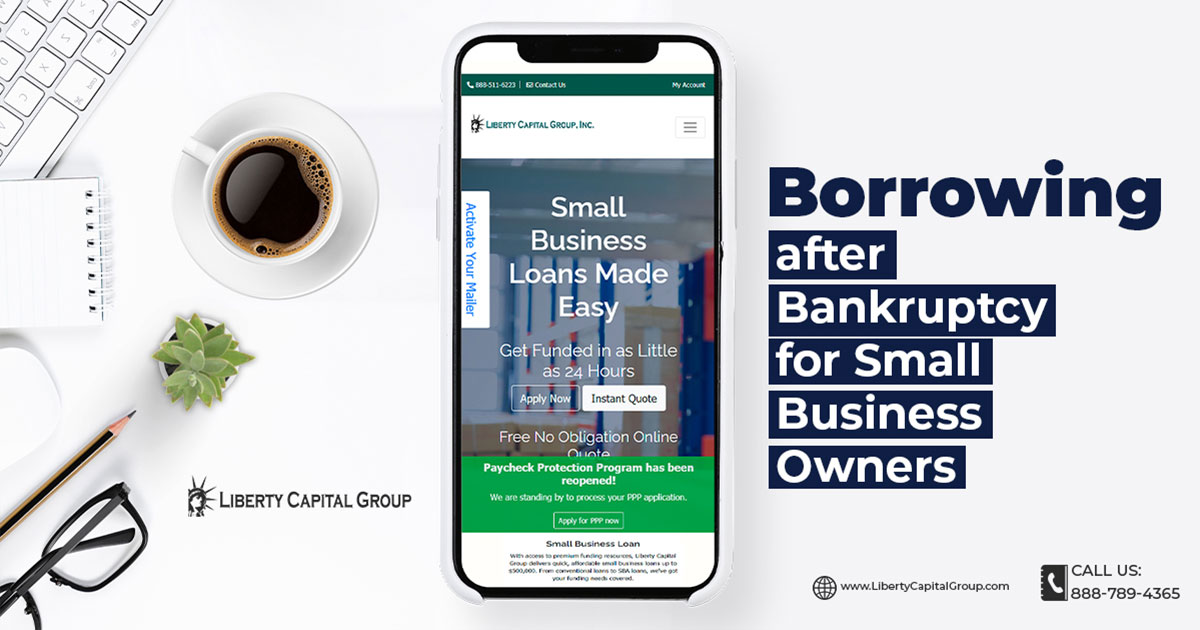
Jul
19
Borrowing After Bankruptcy for Small Business Owners
If your business bankruptcy has recently been discharged, most lenders still consider your business high risk. Depending on the type of bankruptcy, your personal credit might have been affected negatively as well.  To help get your business back on track, you may question whether you can consider some form of business financing in the near future.
To help get your business back on track, you may question whether you can consider some form of business financing in the near future.
There are a surprising number of lenders that are still willing to provide working capital for businesses with recent bankruptcies. But if you expect to get the best rate, a longer-term, or a larger sum, you will be sorely disappointed.
One form of business funding is called Merchant Cash Advance. For businesses with credit card sales, a Merchant Cash Advance is the easiest way to get capital over any other form of business borrowing. With a Merchant Cash Advance, lenders use your future credit card sales as collateral against the cash advance. As a security precaution, in case of a default, cash advance lenders can instruct your credit card processor to directly withhold all credit card batches, or route your credit card sales to their account until the cash advance has been fully satisfied. This form of business funding is suitable for the risk they’re taking on someone with a recent bankruptcy.
Most merchant cash advance lenders are less restrictive as long as you have a high credit card sales volume. Since payments are taken directly from your credit card sales, through your processor, the lenders are able to recoup their investment quickly and safely. Payment withholding through your credit card processor allows them to get their money even before you get yours.
Although a Merchant Cash Advance can provide some capital, you don’t hold the cards when it comes to negotiating power. You’re likely to get funded up to 50% of your monthly credit card sales for the short term. As you renew for more capital, the lender typically reviews your payment history with them, your business sales volume, and your bank account, in addition to your debt to income ratios.
Here are some tips to help you when getting business working capital after a recent bankruptcy, whether to purchase equipment, for business expansion or capital for inventory:
- Work with a lender who can help you re-establish your business credit. Getting a new car loan can help you re-establish your personal credit but won’t help on the business side.
- Limit the number of times you apply for capital. A Merchant Cash Advance lender will pull your credit score but will also base their decision on your cash flow, credit card sales and your capacity to remain in business throughout the term of the advance. Almost all Merchant Cash Advance creditors will allow you to renew your advance when you’ve reached 50+% of your cash advance or more than half of the balance owed. Therefore refinancing your Merchant Cash Advance for additional capital will increase your ability to access a higher funding amount. Many small business owners who take a Merchant Cash Advance after bankruptcy find this to be their only lifeline.
- Don’t expect to get approved for a Merchant Cash Advance if your BK discharge is less than a year old. Banks won’t even consider you for at least five years after the release from bankruptcy. Some financial institutions will only consider you if you have a strong guarantor or can provide huge collateral. You will probably not be able to provide the latter if you have just recently discharged your debt.
- Expect to pay interest rates that are well above the typical bank loan rates. Initially, you will be paying extremely high interest on any of your borrowing while you re-establishing your credit. Lenders are less likely to take a chance on you or your business until you have proven you have resolved your financial difficulties. You will undoubtedly run into problems procuring a loan with a bankruptcy that is between one to two years old. Even after your credit score has risen, you will still have trouble being approved for financing at a traditional bank.
- Even though you pay down your cash advance in a timely manner, this information is not sent to the credit bureaus, so your credit score does not improve. You probably will notice a UCC lien against your business as this is a means for the lender to ensure that you will pay back the advance. The important issue here is that you show the ability of your business to repay the advance responsibly, which will lead to better deals in the future. Most Merchant Cash Advance have a short repayment term owing to the risk factor involved. The good news is that, once the advance has been repaid, you are eligible for a renewal and, hopefully at a better rate and longer-term.
- Negotiate your Merchant Cash Advance during the renewal or refinancing process. Once you have shown your ability to meet your financial obligation, your business will have a UCC filing indicating to potential lenders that you were once more capable of acquiring funding and paying back the advance. You are now of interest to those lenders who subscribe to UCC filing alerts.
- Because you are an unknown quantity after a bankruptcy, the amount of any cash advance approved will be low and the repayment term quite short. Most Merchant Cash Advance lenders will not give you more than 50% of your monthly cash flow, and usually less. You might start with a very short-term advance, but you can gradually increase the term’s length as you refinance.
- When applying for any form of Merchant Cash Advance, you might think that multiple offers are in your best interest. On the contrary, if you start inquiring about financing just recently out of bankruptcy, you will only hinder any chance of approval. In a financier’s eyes, you are continuing to acting in a financially unreliable manner, which they feel is what led to the bankruptcy in the first place.
Filling out numerous forms online is not a good option for obtaining financing. Most sites you apply to are just lead-generating companies that will sell your application to a variety of brokers and lenders. This in turn causes your credit to be pulled by various financial institutions, consequently lowering your score further. Excessive inquiries after bankruptcy will not help you repair your damaged credit. Only apply for financing when it is necessary and accept any decent offer made to you to avoid multiple inquiries. Chances are that you won’t get the money you want for the term and rate you are looking for during that first attempt to borrow after a bankruptcy.
The best approach to rebuilding after a recent bankruptcy is to create your trade lines, establish your business vendors, rack up vendor credit lines and build your bank account showing a positive cash flow which in turn makes your business look financially viable.
You might not get the best offer possible but if you have approval, it may be your only option. It would be wise to accept this and start building financial relationships, credit, and payment history. For merchants with credit card sales, your best bet is the Merchant Cash Advance. For businesses without credit card sales, Invoice Factoring might be your only option if you have future receivables.
